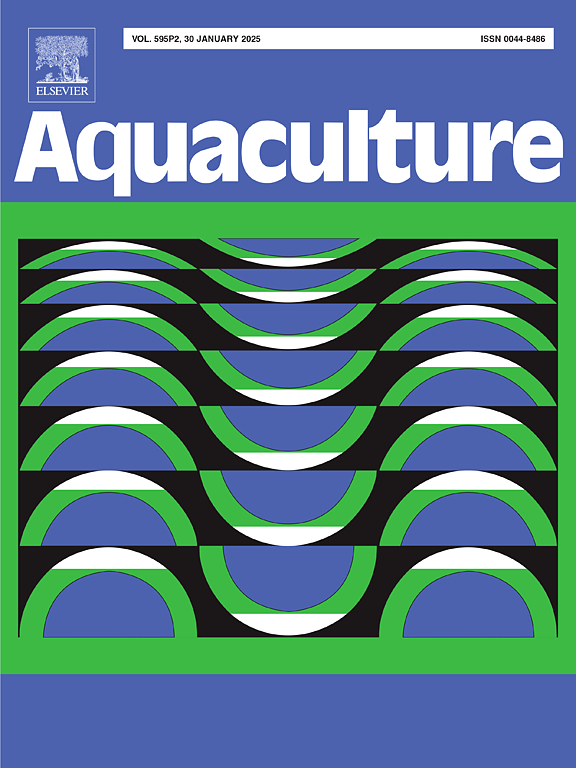对双壳类致病性不同的地中海弧菌菌株之间毒力变化机制的基因组见解
IF 3.9
1区 农林科学
Q1 FISHERIES
引用次数: 0
摘要
幼虫弧菌病,又称细菌性坏死,是一种广泛存在的影响软体动物幼虫发育阶段的细菌性疾病。它经常导致幼虫和幼龄软体动物大量死亡,造成相当大的经济损失。2019年,在贝类孵化场发生的蛏子幼崽大规模死亡事件中,地中海弧菌被确定为幼虫弧菌病的病原体。值得注意的是,观察到的致病性不是弧菌属的物种特异性特征。为了研究地中海弧菌的致病机制,我们对不同毒力菌株进行了全基因组测序、基因组比较分析和生物学比较,并探讨了地中海弧菌可能的主要毒力因素。我们的研究结果表明,地中海弧菌具有相似的GC含量(~ 44%)和基因组组成,包括两条染色体和不同数量的质粒。然而,高毒力菌株具有更大的基因组大小、更多的基因、前噬菌体和毒力相关基因。此外,不同毒力的地中海弧菌在固体表面的粘附能力和生物膜形成能力也不同。基因组比较显示,在高毒力菌株中存在菌株特异性致病性岛(PAI),称为TCP-PAI。该PAI与人类病原体霍乱弧菌中发现的关键毒力因子TCP基因簇具有相似的基因组结构和氨基酸特征。通过对21株地中海弧菌的比较分析,进一步证实了TCP-PAI在不同致病菌株中的存在,强调了TCP-PAI在地中海弧菌对双壳类动物致病性中的作用。本研究首次在地中海弧菌中发现了与霍乱弧菌TCP基因簇相关的关键毒力因子,为进一步研究双壳类动物弧菌病的致病机制提供了基础。本文章由计算机程序翻译,如有差异,请以英文原文为准。

Genomic insights into mechanism underlying virulence variations between Vibrio mediterranei strains different in pathogenicity toward bivalves
Larval vibriosis, also known as bacillary necrosis, is a widespread bacterial disease that affects the larval development stages of mollusks. It often results in significant mortality among larvae and juvenile mollusks, leading to considerable economic losses. In 2019, during a mass mortality event of razor clam (Sinonovacula constricta) juveniles at a shellfish hatchery, Vibrio mediterranei was identified as the causative agent of larval vibriosis. Notably, the observed pathogenicity was not a species-specific characteristic of the Vibrio genus. To investigate the pathogenesis of V. mediterranei strains, we performed whole genome sequencing, genomic comparative analysis, and biological comparisons of strains with differing virulence, and explored the putative main virulence factors of V. mediterranei. Our findings showed that V. mediterranei strains exhibited similar GC content (∼44 %) and genomic compositions, including two chromosomes and varying numbers of plasmids. However, the high virulence strains have larger genome size, more genes, prophages and virulence-associated genes. Additionally, V. mediterranei strains with different virulence exhibited varying capacities for adhesion and biofilm formation on solid surfaces. Genomic comparisons revealed a strain-specific pathogenicity island (PAI), termed TCP-PAI, in high virulence strains. This PAI shared a similar genomic structure and amino acid identity with the key virulence factor, the TCP gene cluster, found in the human pathogen Vibrio cholerae. A comparative analysis of twenty-one V. mediterranei strains further confirmed the presence of TCP-PAI in different pathogenic strains, highlighting the role of TCP-PAI in the pathogenicity of V. mediterranei toward bivalves. This study is the first to identify a key virulence factor in V. mediterranei linked to the TCP gene cluster of V. cholerae, providing a basis for further investigation into the pathogenic mechanisms of vibriosis in bivalves.
求助全文
通过发布文献求助,成功后即可免费获取论文全文。
去求助
来源期刊

Aquaculture
农林科学-海洋与淡水生物学
CiteScore
8.60
自引率
17.80%
发文量
1246
审稿时长
56 days
期刊介绍:
Aquaculture is an international journal for the exploration, improvement and management of all freshwater and marine food resources. It publishes novel and innovative research of world-wide interest on farming of aquatic organisms, which includes finfish, mollusks, crustaceans and aquatic plants for human consumption. Research on ornamentals is not a focus of the Journal. Aquaculture only publishes papers with a clear relevance to improving aquaculture practices or a potential application.
 求助内容:
求助内容: 应助结果提醒方式:
应助结果提醒方式:


